Yuqiang Xie
MAGI: Multi-Agent Guided Interview for Psychiatric Assessment
Apr 25, 2025Abstract:Automating structured clinical interviews could revolutionize mental healthcare accessibility, yet existing large language models (LLMs) approaches fail to align with psychiatric diagnostic protocols. We present MAGI, the first framework that transforms the gold-standard Mini International Neuropsychiatric Interview (MINI) into automatic computational workflows through coordinated multi-agent collaboration. MAGI dynamically navigates clinical logic via four specialized agents: 1) an interview tree guided navigation agent adhering to the MINI's branching structure, 2) an adaptive question agent blending diagnostic probing, explaining, and empathy, 3) a judgment agent validating whether the response from participants meet the node, and 4) a diagnosis Agent generating Psychometric Chain-of- Thought (PsyCoT) traces that explicitly map symptoms to clinical criteria. Experimental results on 1,002 real-world participants covering depression, generalized anxiety, social anxiety and suicide shows that MAGI advances LLM- assisted mental health assessment by combining clinical rigor, conversational adaptability, and explainable reasoning.
SkyScript-100M: 1,000,000,000 Pairs of Scripts and Shooting Scripts for Short Drama
Aug 18, 2024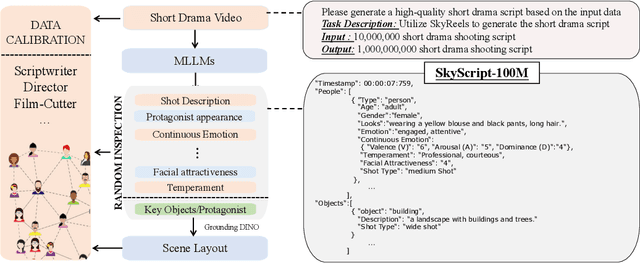
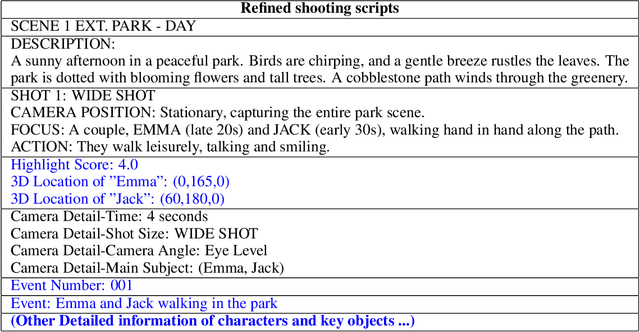
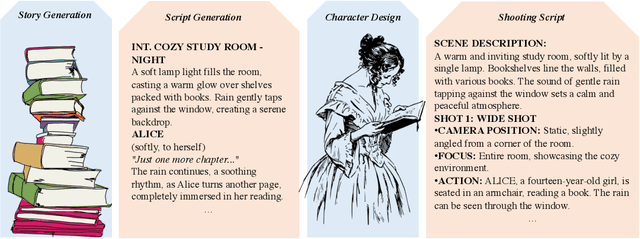
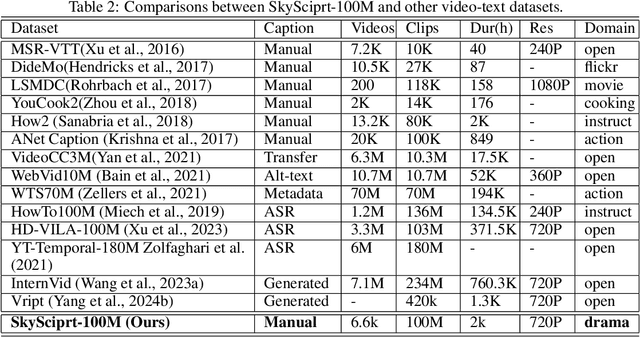
Abstract:Generating high-quality shooting scripts containing information such as scene and shot language is essential for short drama script generation. We collect 6,660 popular short drama episodes from the Internet, each with an average of 100 short episodes, and the total number of short episodes is about 80,000, with a total duration of about 2,000 hours and totaling 10 terabytes (TB). We perform keyframe extraction and annotation on each episode to obtain about 10,000,000 shooting scripts. We perform 100 script restorations on the extracted shooting scripts based on our self-developed large short drama generation model SkyReels. This leads to a dataset containing 1,000,000,000 pairs of scripts and shooting scripts for short dramas, called SkyScript-100M. We compare SkyScript-100M with the existing dataset in detail and demonstrate some deeper insights that can be achieved based on SkyScript-100M. Based on SkyScript-100M, researchers can achieve several deeper and more far-reaching script optimization goals, which may drive a paradigm shift in the entire field of text-to-video and significantly advance the field of short drama video generation. The data and code are available at https://github.com/vaew/SkyScript-100M.
A Group Fairness Lens for Large Language Models
Dec 24, 2023Abstract:The rapid advancement of large language models has revolutionized various applications but also raised crucial concerns about their potential to perpetuate biases and unfairness when deployed in social media contexts. Evaluating LLMs' potential biases and fairness has become crucial, as existing methods rely on limited prompts focusing on just a few groups, lacking a comprehensive categorical perspective. In this paper, we propose evaluating LLM biases from a group fairness lens using a novel hierarchical schema characterizing diverse social groups. Specifically, we construct a dataset, GFair, encapsulating target-attribute combinations across multiple dimensions. In addition, we introduce statement organization, a new open-ended text generation task, to uncover complex biases in LLMs. Extensive evaluations of popular LLMs reveal inherent safety concerns. To mitigate the biases of LLM from a group fairness perspective, we pioneer a novel chain-of-thought method GF-Think to mitigate biases of LLMs from a group fairness perspective. Experimental results demonstrate its efficacy in mitigating bias in LLMs to achieve fairness.
DiffusEmp: A Diffusion Model-Based Framework with Multi-Grained Control for Empathetic Response Generation
Jun 02, 2023



Abstract:Empathy is a crucial factor in open-domain conversations, which naturally shows one's caring and understanding to others. Though several methods have been proposed to generate empathetic responses, existing works often lead to monotonous empathy that refers to generic and safe expressions. In this paper, we propose to use explicit control to guide the empathy expression and design a framework DiffusEmp based on conditional diffusion language model to unify the utilization of dialogue context and attribute-oriented control signals. Specifically, communication mechanism, intent, and semantic frame are imported as multi-grained signals that control the empathy realization from coarse to fine levels. We then design a specific masking strategy to reflect the relationship between multi-grained signals and response tokens, and integrate it into the diffusion model to influence the generative process. Experimental results on a benchmark dataset EmpatheticDialogue show that our framework outperforms competitive baselines in terms of controllability, informativeness, and diversity without the loss of context-relatedness.
FADO: Feedback-Aware Double COntrolling Network for Emotional Support Conversation
Nov 01, 2022Abstract:Emotional Support Conversation (ESConv) aims to reduce help-seekers'emotional distress with the supportive strategy and response. It is essential for the supporter to select an appropriate strategy with the feedback of the help-seeker (e.g., emotion change during dialog turns, etc) in ESConv. However, previous methods mainly focus on the dialog history to select the strategy and ignore the help-seeker's feedback, leading to the wrong and user-irrelevant strategy prediction. In addition, these approaches only model the context-to-strategy flow and pay less attention to the strategy-to-context flow that can focus on the strategy-related context for generating the strategy-constrain response. In this paper, we propose a Feedback-Aware Double COntrolling Network (FADO) to make a strategy schedule and generate the supportive response. The core module in FADO consists of a dual-level feedback strategy selector and a double control reader. Specifically, the dual-level feedback strategy selector leverages the turn-level and conversation-level feedback to encourage or penalize strategies. The double control reader constructs the novel strategy-to-context flow for generating the strategy-constrain response. Furthermore, a strategy dictionary is designed to enrich the semantic information of the strategy and improve the quality of strategy-constrain response. Experimental results on ESConv show that the proposed FADO has achieved the state-of-the-art performance in terms of both strategy selection and response generation. Our code is available at https://github/after/reviewing.
Psychology-guided Controllable Story Generation
Oct 14, 2022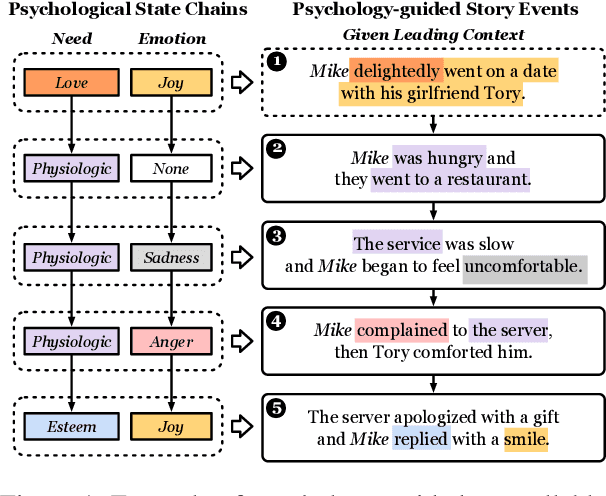
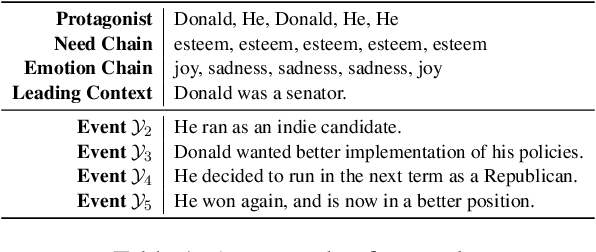

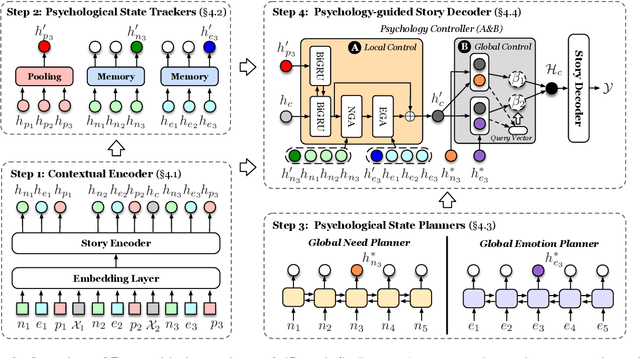
Abstract:Controllable story generation is a challenging task in the field of NLP, which has attracted increasing research interest in recent years. However, most existing works generate a whole story conditioned on the appointed keywords or emotions, ignoring the psychological changes of the protagonist. Inspired by psychology theories, we introduce global psychological state chains, which include the needs and emotions of the protagonists, to help a story generation system create more controllable and well-planned stories. In this paper, we propose a Psychology-guIded Controllable Story Generation System (PICS) to generate stories that adhere to the given leading context and desired psychological state chains for the protagonist. Specifically, psychological state trackers are employed to memorize the protagonist's local psychological states to capture their inner temporal relationships. In addition, psychological state planners are adopted to gain the protagonist's global psychological states for story planning. Eventually, a psychology controller is designed to integrate the local and global psychological states into the story context representation for composing psychology-guided stories. Automatic and manual evaluations demonstrate that PICS outperforms baselines, and each part of PICS shows effectiveness for writing stories with more consistent psychological changes.
COMMA: Modeling Relationship among Motivations, Emotions and Actions in Language-based Human Activities
Sep 14, 2022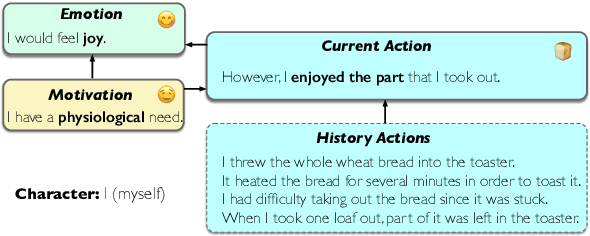

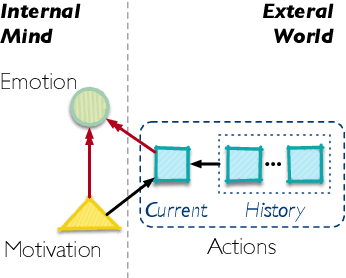
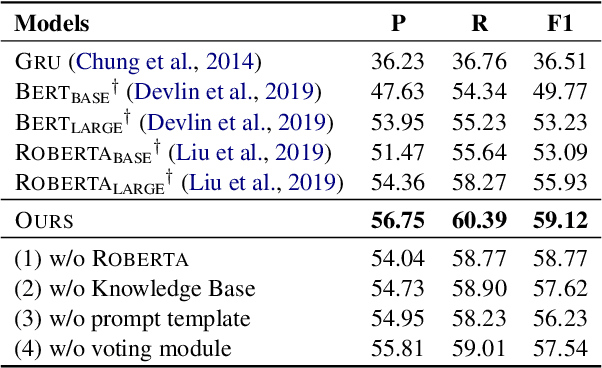
Abstract:Motivations, emotions, and actions are inter-related essential factors in human activities. While motivations and emotions have long been considered at the core of exploring how people take actions in human activities, there has been relatively little research supporting analyzing the relationship between human mental states and actions. We present the first study that investigates the viability of modeling motivations, emotions, and actions in language-based human activities, named COMMA (Cognitive Framework of Human Activities). Guided by COMMA, we define three natural language processing tasks (emotion understanding, motivation understanding and conditioned action generation), and build a challenging dataset Hail through automatically extracting samples from Story Commonsense. Experimental results on NLP applications prove the effectiveness of modeling the relationship. Furthermore, our models inspired by COMMA can better reveal the essential relationship among motivations, emotions and actions than existing methods.
Do You Know My Emotion? Emotion-Aware Strategy Recognition towards a Persuasive Dialogue System
Jun 24, 2022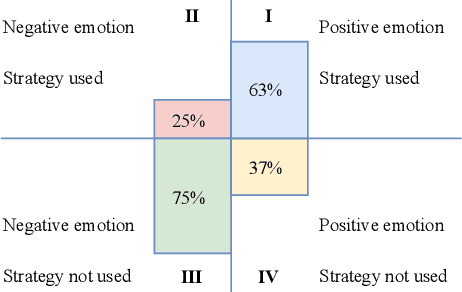
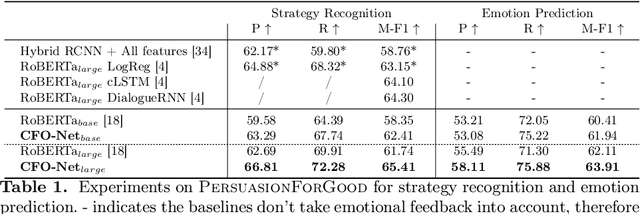
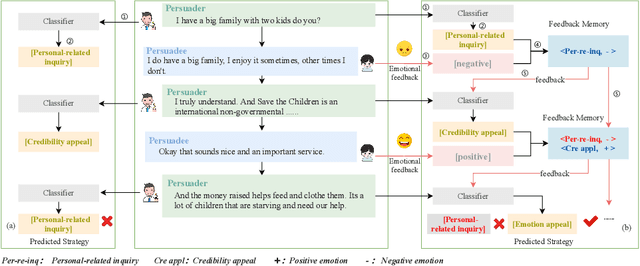

Abstract:Persuasive strategy recognition task requires the system to recognize the adopted strategy of the persuader according to the conversation. However, previous methods mainly focus on the contextual information, little is known about incorporating the psychological feedback, i.e. emotion of the persuadee, to predict the strategy. In this paper, we propose a Cross-channel Feedback memOry Network (CFO-Net) to leverage the emotional feedback to iteratively measure the potential benefits of strategies and incorporate them into the contextual-aware dialogue information. Specifically, CFO-Net designs a feedback memory module, including strategy pool and feedback pool, to obtain emotion-aware strategy representation. The strategy pool aims to store historical strategies and the feedback pool is to obtain updated strategy weight based on feedback emotional information. Furthermore, a cross-channel fusion predictor is developed to make a mutual interaction between the emotion-aware strategy representation and the contextual-aware dialogue information for strategy recognition. Experimental results on \textsc{PersuasionForGood} confirm that the proposed model CFO-Net is effective to improve the performance on M-F1 from 61.74 to 65.41.
CogIntAc: Modeling the Relationships between Intention, Emotion and Action in Interactive Process from Cognitive Perspective
May 16, 2022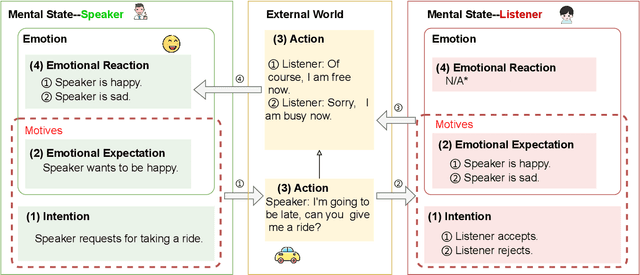


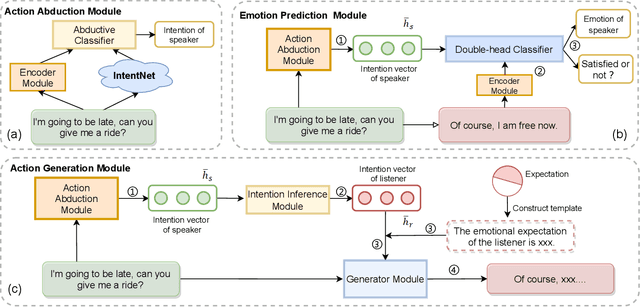
Abstract:Intention, emotion and action are important psychological factors in human activities, which play an important role in the interaction between individuals. How to model the interaction process between individuals by analyzing the relationship of their intentions, emotions, and actions at the cognitive level is challenging. In this paper, we propose a novel cognitive framework of individual interaction. The core of the framework is that individuals achieve interaction through external action driven by their inner intention. Based on this idea, the interactions between individuals can be constructed by establishing relationships between the intention, emotion and action. Furthermore, we conduct analysis on the interaction between individuals and give a reasonable explanation for the predicting results. To verify the effectiveness of the framework, we reconstruct a dataset and propose three tasks as well as the corresponding baseline models, including action abduction, emotion prediction and action generation. The novel framework shows an interesting perspective on mimicking the mental state of human beings in cognitive science.
Control Globally, Understand Locally: A Global-to-Local Hierarchical Graph Network for Emotional Support Conversation
Apr 27, 2022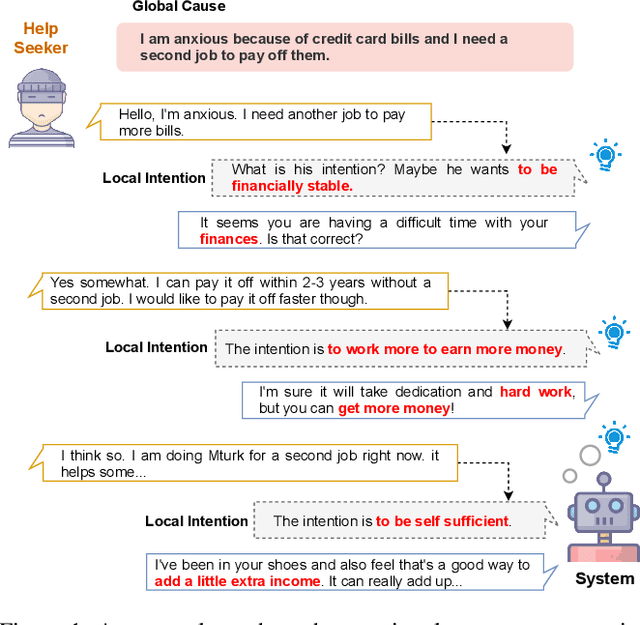

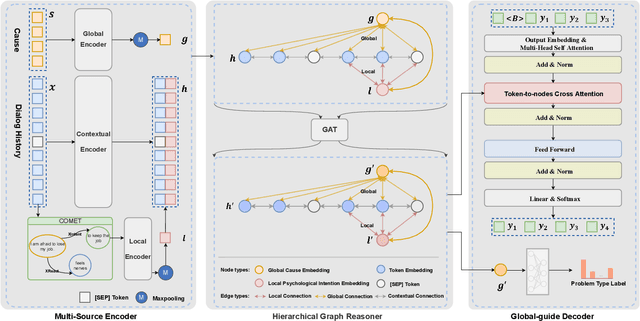
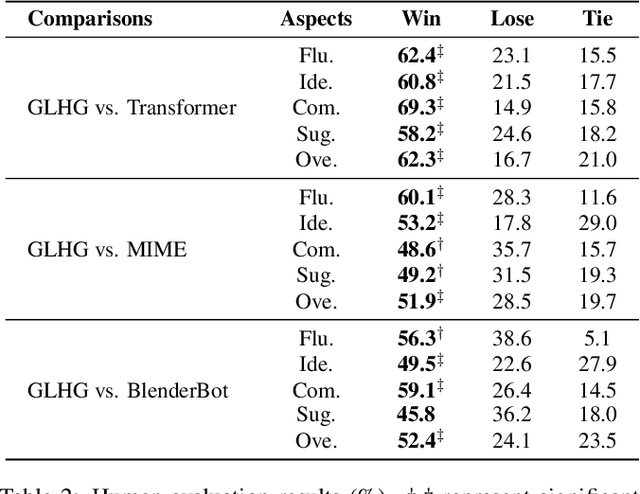
Abstract:Emotional support conversation aims at reducing the emotional distress of the help-seeker, which is a new and challenging task. It requires the system to explore the cause of help-seeker's emotional distress and understand their psychological intention to provide supportive responses. However, existing methods mainly focus on the sequential contextual information, ignoring the hierarchical relationships with the global cause and local psychological intention behind conversations, thus leads to a weak ability of emotional support. In this paper, we propose a Global-to-Local Hierarchical Graph Network to capture the multi-source information (global cause, local intentions and dialog history) and model hierarchical relationships between them, which consists of a multi-source encoder, a hierarchical graph reasoner, and a global-guide decoder. Furthermore, a novel training objective is designed to monitor semantic information of the global cause. Experimental results on the emotional support conversation dataset, ESConv, confirm that the proposed GLHG has achieved the state-of-the-art performance on the automatic and human evaluations.
 Add to Chrome
Add to Chrome Add to Firefox
Add to Firefox Add to Edge
Add to Edge